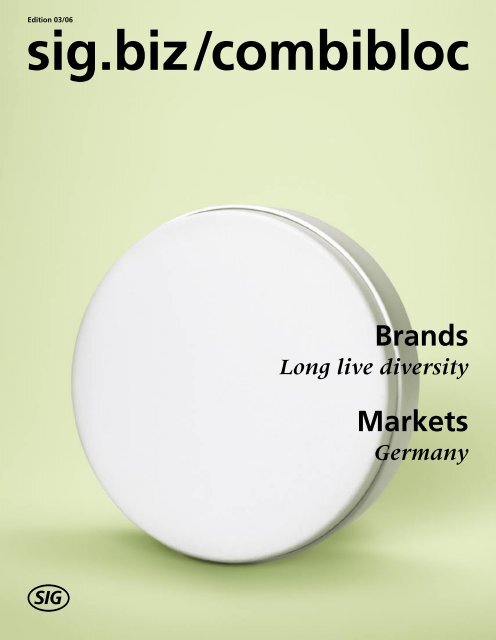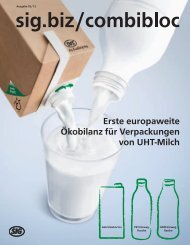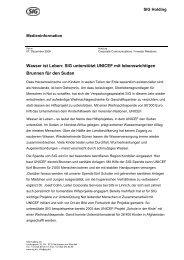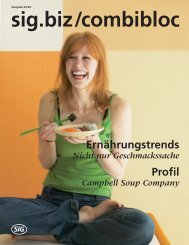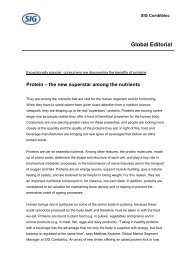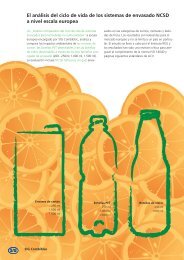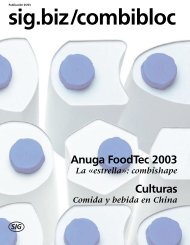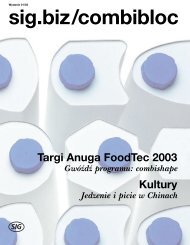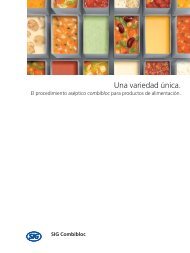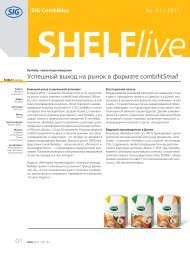You also want an ePaper? Increase the reach of your titles
YUMPU automatically turns print PDFs into web optimized ePapers that Google loves.
Edition 03/06<br />
sig.biz/combibloc<br />
Brands<br />
Long live diversity<br />
Markets<br />
Germany
Editorial<br />
Dear Readers,<br />
Imagine that from one day to the<br />
next, all brands disappeared worldwide.<br />
What should one buy? Which make to<br />
trust? How to take decisions? In other<br />
words: only brands allow products to stand<br />
out among the mass of others on offer and<br />
differentiate them unmistakably. Brands are<br />
the outright key to market success. Any<br />
company that recognises this fact will not<br />
be willing to jeopardise this invaluable asset:<br />
the association of its products with a promise<br />
on which the consumer relies. One<br />
aspect is ultimately essential for the future<br />
and success of any brand: consumer confidence.<br />
Read more about the subject in our<br />
title story.<br />
In this issue, our section on markets is<br />
focused on two interesting countries. On<br />
the one hand, the emphasis is on the rapid<br />
economic upswing of Kazakhstan which,<br />
increasingly, is developing into a commercial<br />
hub and marketplace between West and<br />
East, between Europe and Asia. On the<br />
other, we examine the extremely dynamic<br />
situation on the German market and the<br />
perspectives for <strong>SIG</strong> <strong>Combibloc</strong>.<br />
Last but not least, our environment<br />
section includes a report on the Children’s<br />
Conference in Malaysia, organised by<br />
the UNEP, United Nations Environment<br />
Programme, and the active participation of<br />
<strong>SIG</strong> in that event.<br />
If you prefer to click rather than read,<br />
I can strongly recommend a visit to our online<br />
magazine. At www.sig.biz/combibloc<br />
Imprint<br />
sig.biz/combibloc, winter 2006 Published by <strong>SIG</strong> <strong>Combibloc</strong> International AG, Laufengasse 18, 8212 Neuhausen am Rheinfall, Switzerland Editors Dr Bettina Horenburg,<br />
Martina Loewe, Attakrit Singhaseni, Heike Thevis, Wojciech Wroczynski, Darja Safronova, Luciana Galvão, María José Madroñal, Dr Isabella Classen, RTS Rieger Team<br />
Concept and design RTS Rieger Team Werbeagentur GmbH, Düsseldorf Pictures <strong>SIG</strong> <strong>Combibloc</strong>, RTS Rieger Team, Masterfile, Getty Images, Jupiter Images, Zefa Lithography<br />
Weß + Lüer GmbH, Willich Printed by Meier Print Schaffhausen, Feuerthalen Contact Phone: +41 (0)52 674 7716, Fax: +41 (0)52 674 6556, E-mail: bettina horenburg@sig.biz<br />
Internet www.sigcombibloc.com sig.biz/combibloc is published in German, <strong>English</strong>, Spanish, French, Italian, Portuguese, Polish, Russian and Chinese. All rights reserved. Articles<br />
indicated as being contributed by other writers do not necessarily reflect the views of the publisher. No part of this publication may be reproduced or electronically distributed<br />
without the prior permission of the editorial team.<br />
sig.biz/combibloc 03/ 06<br />
you will not only find all the articles<br />
contained in our customer publication, but<br />
also a wealth of other relevant data and<br />
information.<br />
Enjoy your personal issue of sig.biz/combibloc.<br />
Sincerely yours,<br />
Rolf-Dieter Rademacher<br />
CEO
Contents Seite<br />
Editorial & imprint 2<br />
News<br />
Première for combifitMidi in Spain 4<br />
Spanish milk producer Leche Celta presents an innovative new package<br />
for its product “Celta Energía y Crecimiento” (energy and growth).<br />
For modern nomads 5<br />
The company Hanmi Whole Soymilk Co. Ltd. has launched a new soup concept<br />
on the South Korean market – conveniently packaged in combiblocMini.<br />
Title<br />
The power of brands 6<br />
Why trust is the most valuable asset and promises have to be kept.<br />
Profile<br />
Centenary of the dairy in Łowicz 14<br />
Interview with Chairman Jan Da˛ browski about the history of<br />
the dairy and its future perspectives.<br />
Facts & Trends<br />
Babies thrive on quality 18<br />
The carton has become internationally established as a convincing<br />
packaging system for the sensitive segment of ready-to-consume baby foods.<br />
Cultures<br />
Flavours of Thailand 22<br />
Cooking with combibloc: two recipes from Thailand’s rich culinary tradition.<br />
Markets<br />
Boom in Eurasia 24<br />
Dynamic development in Kazakhstan and <strong>SIG</strong> <strong>Combibloc</strong>’s activities in the market.<br />
A market in transition 28<br />
Full of new challenges: the German market is moving.<br />
What is happening at <strong>SIG</strong> <strong>Combibloc</strong>?<br />
Environment<br />
<strong>SIG</strong> supports UNEP International Children’s Conference 32<br />
Financially and practically, <strong>SIG</strong> Group sponsors a conference in Malaysia<br />
organised by the United Nations Environment Programme.<br />
Articles marked with these pictograms also have the following features in the online magazine:<br />
Contents 2/3<br />
Texts Links<br />
Images Audio files Videos<br />
sig.biz/combibloc 03/ 06
News Section/Rubrik<br />
Première for combifitMidi<br />
in Spain<br />
In October 2006, Spanish milk producer Leche Celta presented the new package for its product<br />
“Celta Energía y Crecimiento” (energy and growth): combifitMidi<br />
Producers of dairy products are also<br />
constantly seeking ways and means to differentiate<br />
their merchandise from that of the<br />
competition. For this reason, <strong>SIG</strong> <strong>Combibloc</strong><br />
conducted a market survey to compare<br />
diverse new formats for the 1-litre volume<br />
against existing ones. One of the most important<br />
results revealed that housewives<br />
perceive combifitMidi as a modern and innovative<br />
packaging form that is outstandingly<br />
suitable for premium dairy products.<br />
New design and décor<br />
As recently as 2005, the Spanish dairy<br />
products producer, Leche Celta, announced<br />
its interest in this format, and now – barely<br />
one year later – the filling line is already<br />
installed and operational. The benefits of the<br />
sig.biz/combibloc 03/ 06<br />
Unique in Spain: Celta Energía y Crecimiento.<br />
A milk grade specifically for children, packaged<br />
in combifitMidi (1,000 ml).<br />
new format – modern, innovative design concept,<br />
ease and convenience of handling –<br />
immediately appealed to the Spanish enterprise.<br />
The closure solution combiTwist was<br />
also extremely well received. In October, the<br />
customer relaunched its product “Celta Energía<br />
y Crecimiento” (energy and growth) in<br />
combifitMidi fitted with the practical screw cap.<br />
Hitherto, this special grade milk for children<br />
has been marketed in combiblocSlimline.<br />
For healthy growth<br />
Celta Energía y Crecimiento is a milk<br />
grade that is enriched with calcium and<br />
twelve vitamins; it is highly suitable for<br />
growing children and juveniles. Milk plays<br />
a decisive role in this phase of physical<br />
and mental development. It is an ideal<br />
complement in achieving a balanced and<br />
varied diet.<br />
In order to support the market launch<br />
of this product, two appropriate special<br />
supplements were produced for selected<br />
specialist magazines. In the foreseeable future,<br />
Leche Celta intends to roll out a new<br />
premium UHT milk product on the Spanish<br />
market packaged in combifitMidi.<br />
Further information available in our<br />
online magazine at:<br />
www.sig.biz/combibloc/news
For modern nomads<br />
Just right for today’s fast-moving world, Hanmi Whole Soymilk Co. Ltd has launched a<br />
new soup concept in combiblocMini on the South Korean market. A time-saving and<br />
yet healthy substitute meal for busy working people, the concept is perfectly attuned to<br />
the taste buds of Asian consumers.<br />
Rich in valuable fibre, KongGukMul<br />
brand soy soup is served hot with noodles for<br />
breakfast. This innovative concept in ready<br />
meals appeals particularly to the burgeoning<br />
health-conscious consumer sector – a group<br />
that is constantly growing. In Asia, sales of<br />
soy products increased by 27 per cent in 2005.<br />
Thus, Hanmi’s soy soup has all the potential<br />
for becoming a true bestseller.<br />
Soup to go<br />
The Asian palate is accustomed to the<br />
‘beany’ taste of soy beans and appreciates<br />
the distinctive flavour. Unlike in other parts<br />
of the world, no additives are needed to disguise<br />
the natural flavour of the soup. Hanmi’s<br />
soup is manufactured to a new recipe, giving<br />
it the consistency of a light broth. Packaged<br />
in the slim combiblocMini carton, the product<br />
can be transported easily and securely.<br />
Particularly hungry consumers, or anyone<br />
in a hurry, can drink the soup snack directly<br />
from the carton using a straw. It is ideal as<br />
a time-saving meal replacement and as a<br />
supplement for a balanced, nutritious diet.<br />
Consequently, Hanmi soy soup is the<br />
perfect alternative for modern nomads –<br />
working people who do not want to squander<br />
their limited time with cooking complicated<br />
meals.<br />
Proven recipe for success<br />
Traditional stone-ground soybean soup<br />
has been served successfully for generations.<br />
Now, by blending tradition with technology,<br />
Hanmi has created the spirit of the times for<br />
sig.biz/combibloc News 4/5 5/5<br />
A fully-fledged meal for anyone on the go: soybean<br />
soup from Hanmi Whole Soymilk Co. Ltd.,<br />
conveniently packaged in combiblocMini.<br />
the modern consumer: a time-honoured<br />
recipe combined with cutting-edge packaging<br />
technology.<br />
Further information available in our<br />
online magazine at:<br />
www.sig.biz/combibloc/news<br />
sig.biz/combibloc 03/ 06
Title<br />
sig.biz/combibloc 03/ 06
The power of brands<br />
Just imagine if all brands disappeared overnight. What to buy? Which make to trust?<br />
How to take decisions? Brands are an integral part of our everyday life; they are ubiquitous.<br />
Whether products or services are involved, we depend on brands and trust them. Why exactly?<br />
Title 6/7<br />
sig.biz/combibloc 03/ 06
Title<br />
Brands make life easier and provide a<br />
better overview. Brands save time because<br />
they are information vehicles and relieve<br />
the consumer of having to check, question<br />
and classify everything. Brands reduce the<br />
risk of poor purchase decisions because<br />
branded products promise consistently high<br />
quality. Brands also have perceived benefits<br />
because they highlight the individuality<br />
of the consumer. They support the selfportrayal<br />
of individuals and demonstrate<br />
their affiliation with a specific social group.<br />
Any woman will confirm that a handbag<br />
from Louis Vuitton is simply something<br />
more than just a handbag.<br />
From the heart<br />
In branding, the emotional element is<br />
everything. When the differences between<br />
attributes of two competing products are<br />
marginal, then it is the consumer’s emotions<br />
that forces the decision: which brand promises<br />
what I am seeking? Appeal or prestige,<br />
individuality or adventure, quality or price<br />
advantage? Decisions in favour of a brand<br />
are decisions of the heart, because any well-<br />
sig.biz/combibloc 03/ 06<br />
managed brand is a being with a heart of its<br />
own. The analogy between human beings<br />
and brands is not new. In the 1930s already,<br />
Hans Domizlaff, the doyen of marketers,<br />
claimed that a brand has a human face.<br />
At eye level<br />
In this context, marketing has less and<br />
less to do with selling. Marketing means<br />
appealing to customers at the most sophisticated<br />
level. Successful brands no longer<br />
simply stand for a product. They reflect a<br />
lifestyle, illustrate the consumer’s world, convey<br />
values, embody emotions and desires,<br />
suggest authenticity and trust. When this<br />
balancing act is achieved, customers remain<br />
loyal to that brand.<br />
Through brands, consumers automatically<br />
associate the message with being plausible<br />
and authentic. This is a process that may<br />
take years to establish successfully, because<br />
consumers must be able to relate to all statements<br />
made about the brand. To sustain this<br />
perception, brands must constantly adapt to<br />
any changes in the market: a tightrope act<br />
between dynamics and identity.<br />
Image is nothing? Not quite. Brands have<br />
perceived benefits because they highlight the<br />
individuality of the consumer.
Consequently, the secret of marketing<br />
lies in authenticity. No matter what “adaptations”<br />
are involved, there must always be a<br />
bridge to the effective image. How is this<br />
done? How does one go about building a<br />
brand nowadays?<br />
Breaking the mould<br />
A brand is a name, concept, message,<br />
symbol, shape, or any combination of those<br />
elements, that make products or services<br />
stand out. It differentiates them from the<br />
competition. As a first step, a brand communicates<br />
the origin of the product, because<br />
only the brand owner has the right to market<br />
a product under that specific name. The goal<br />
of brand building is to create consumer preference<br />
for a product that is competing against<br />
similar – and hence, interchangeable – ones<br />
such as chocolate, petrol, detergents or paper<br />
tissues. Providers of branded articles aim at<br />
generating brand consciousness among consumers,<br />
thereby establishing brand loyalty.<br />
Such products emerge from the grey mass<br />
and assume an identity of their own. Brand<br />
loyalty is reflected in greater price tolerance<br />
on the part of consumers. As a rule, they are<br />
more willing to pay a certain premium for<br />
the benefits provided by the brand. Consequently,<br />
branded products are less vulnerable<br />
to attack from competitors.<br />
Brand recognition<br />
Launching a brand is not simply a question<br />
of designing a logo. Converting a product<br />
into a brand first requires brand recognition:<br />
there must be consumer awareness. Existing<br />
consumer perception thresholds may have to<br />
Title 8/9<br />
be overcome. Moreover, communication must<br />
aim at generating brand likeability. Only<br />
when these first two steps have been attained<br />
can the third and critical phase be achieved:<br />
use of the brand by consumers – and hence,<br />
the generation of sales and profits for the<br />
manufacturer.<br />
Brand awareness is not easy to create<br />
because the recall capacity of any individual<br />
is limited. This is all the more applicable considering<br />
that the volume of printed information<br />
doubles every four or five years, when<br />
ever more people have Internet access to<br />
information worldwide and consumers are<br />
confronted with a growing flood of advertising<br />
and product data. Nowadays, consumers<br />
only absorb those messages they perceive as<br />
important. Consequently, even if they are<br />
noticed initially, very few messages achieve<br />
sig.biz/combibloc 03/ 06
Title<br />
the transition leap from the consumers’<br />
short-term memory into their long-term one.<br />
Precisely which messages actually enter a<br />
consumer’s long-term memory is dependent<br />
on a number of individual factors. These<br />
include the consumer’s level of interest,<br />
earlier experiences and emotions at the time<br />
of receiving the message. Hence, brands may<br />
be considered as abbreviations in the longterm<br />
memory. Once they have succeeded<br />
in overcoming the perception threshold,<br />
the consumer links numerous associations<br />
with the brand that, ideally, lead to brand<br />
likeability and brand usage.<br />
Name of the game<br />
Brand building is invariably a long-term<br />
affair and comprises a diversity of measures<br />
and initiatives. A brand policy provides a<br />
bundle of instruments with which to convert<br />
a product into a brand. A key role is played<br />
by the brand name: the verbally conveyed<br />
element in a brand-building exercise. Given<br />
its significance, selecting the right name is<br />
vitally important. The name must be unmistakable,<br />
easy to recognise and pronounce,<br />
and to memorise. Ideally, a brand name will<br />
sig.biz/combibloc 03/ 06<br />
trigger positive product and experience associations<br />
among consumers and suggest<br />
product benefits to them. With globalisation,<br />
it is becoming increasingly difficult to fulfil<br />
those requirements. Obviously, the name<br />
must sound right and trigger positive associations<br />
in many languages and not just one.<br />
Moreover, the name must be suitable for dissemination<br />
via the Internet and not already<br />
be occupied.<br />
Making its mark<br />
The logo is an important element of the<br />
brand-building process. However, whereas<br />
it can be perceived, it cannot be communicated<br />
verbally. It possesses brand-typical<br />
visual attributes for rapid perception and<br />
recognition. A logo should be as unmistakable<br />
and as easy to recognise as the brand<br />
name itself. It should also generate positive<br />
and product or application-typical associations.<br />
As a branding element, shape can relate<br />
to the design of both the product and the<br />
packaging. Moreover, specific details of a<br />
product can exhibit characteristic shapes (e.g.<br />
the radiator grilles of certain automobile
Brands no longer simply stand for a product.<br />
They reflect a lifestyle, convey values and<br />
imply confidence.<br />
marques). When creating shapes, in addition<br />
to consumer perception and recognition,<br />
aesthetic aspects as well as economic and<br />
technological factors have to be taken into<br />
account. With products coming into direct<br />
and frequent physical contact with the<br />
consumer, ergonomic qualities can be of<br />
significance.<br />
Sharper profile<br />
In addition to the optimal exploitation<br />
of the available instruments, a successful<br />
branding policy also depends on the strength<br />
of the market presentation, i.e. establishing<br />
a clear and unmistakable brand profile. Equally<br />
important is consistency in communicating<br />
Title 10/11<br />
the brand. The branding concept must be<br />
seamless and sustained in its implementation.<br />
Only when this interaction functions smoothly<br />
can a lasting brand be built successfully.<br />
Well worth the effort<br />
In the marketplace, successful brands<br />
represent substantial assets that are reflected<br />
in brand awareness, brand penetration,<br />
brand image and ultimately corporate image.<br />
Producers can build on this capital and its<br />
related quality associations to expand a<br />
product range more rapidly and successfully<br />
than unknown providers. Many companies<br />
tend to assume that, unlike more<br />
anonymous items, branded products are not<br />
sig.biz/combibloc 03/ 06
Title<br />
sig.biz/combibloc 03/ 06
The objective of brand building is to generate<br />
consumer preference for a specific product<br />
that exists among many similar and essentially<br />
interchangeable ones.<br />
subject to life-cycle trends or, at least, enjoy<br />
a longer life cycle. America’s Interbrand<br />
Group has developed a system that allows<br />
them to assess the value of a given brand.<br />
In this system, the economic income of the<br />
overall market, the expected market share<br />
of the branded product and the risk profile<br />
of the budgeted revenue from that product<br />
are considered.<br />
All brand, or what?<br />
There is hardly a business venture where<br />
branding is not practised. Nowadays, the technique<br />
is no longer applied to single products<br />
or product families, but more often than not<br />
for the corporate branding of entire groups.<br />
Furthermore, branded articles are not only<br />
restricted to consumer goods, but are found<br />
in virtually every known market sector.<br />
Branding is even applied in areas that are<br />
outside the classic provision of services such<br />
as electricity or water supplies, for example,<br />
sports clubs like Manchester United or sports<br />
events such as Formula 1 racing. In the meantime,<br />
even people are being marketed as<br />
brands, just think of Michael “Air” Jordan or<br />
Claudia Schiffer. Even Germany’s former<br />
Chancellor Gerhard Schröder claimed in his<br />
1998 election campaign, “I am a brand!”. Tiny<br />
computer chips (“Intel inside”), institutions<br />
like the Nasdaq or some famous <strong>English</strong><br />
universities, certain stocks, “social economy”<br />
as an organisational principle, popular tourist<br />
locations such as St Moritz, or even entire<br />
nations, are promoted as brands.<br />
Esperanto of the global economy<br />
Evidently, the concept of branding is so<br />
attractive and adaptable that practically no<br />
aspect of everyday life is considered unworthy<br />
of being classified as suitable for<br />
building up into a brand. This is readily confirmed<br />
by the steadily growing number of<br />
global brands, i.e. those branded products<br />
that enjoy worldwide acceptance. In some<br />
cases, brand names are so widespread and so<br />
well received that one is tempted to classify<br />
them as a global language that, although<br />
largely symbolic, is readily understood everywhere.<br />
Can you imagine anyone who is not<br />
able to associate the cursive white script on<br />
a red background, the yellow domed “M” or<br />
the cowboy taking a break for a smoke with<br />
their respective brands? Exactly!<br />
Title 12/13<br />
Further information available in our<br />
online magazine at:<br />
www.sig.biz/combibloc/title<br />
sig.biz/combibloc 03/ 06
Profile<br />
sig.biz/combibloc 03/ 06
Centenary of the dairy in Łowicz<br />
The District Cooperative Dairy in Łowicz is one of the leading milk processors in the<br />
Polish market. On the occasion of its centenary, we spoke to the Chairman of the dairy,<br />
Jan Da˛ browski, about the how the enterprise was founded and has developed.<br />
sig.biz/combibloc: Round birthdays are<br />
always a good opportunity to reflect on what<br />
has been achieved to date. Can you tell us<br />
about the early beginnings of the Łowicz<br />
Dairy?<br />
Jan Da˛ browski: The establishment and<br />
development of the District Cooperative<br />
Dairy in Łowicz is closely tied to the history<br />
of the entire region. The Łowicz region itself<br />
can look back on a long tradition of highly<br />
diverse cooperatives. At the beginning of the<br />
twentieth century already, farmers began<br />
to organise themselves, thereby laying the<br />
foundations for the cooperatives. In the years<br />
1918–39, Łowicki Powiat included 246 villages,<br />
12 estates, 5 settlements and 2 cities<br />
Being interviewed: Jan Da˛ browski,<br />
Chairman of the District Cooperative Dairy<br />
in Łowicz (Poland).<br />
Glowno and Łowicz. At that time there were<br />
19,000 farms with an average of 46 cattle<br />
per 100 hectares. Wladyslaw Grabski, Prime<br />
Minister of Poland and initiator of a currency<br />
reform, was one of the pioneers of the<br />
cooperative movement in the Łowicki region.<br />
Also among the founders of the dairy cooperatives<br />
were former students of the Blich<br />
Agricultural College. From 1890 onwards,<br />
and particularly after 1918, when Poland became<br />
independent, the number of small dairy<br />
cooperatives grew steadily. 1930 saw the establishment<br />
of the Dampf Dairy Cooperative,<br />
domiciled in Blich, Łowicz. In 1935, the dairy<br />
was transformed into the District Cooperative<br />
Dairy Promien (the ray) with Antoni Bolimowski<br />
as its General Manager.<br />
Profile 14/15<br />
sig.biz/combibloc: Please tell us about<br />
the post-war developments of the Łowicz<br />
Dairy, up to the present day.<br />
Jan Da˛ browski: In 1951, the government<br />
took control of the Łowicz Dairy which,<br />
like all other Polish dairies, operated on the<br />
basis of the prescribed milk quotas that the<br />
farmers were required to deliver. Subsequently,<br />
the company lost money as the milk<br />
was sometimes sold at lower prices than it<br />
had been purchased from the farmers.<br />
Some years later, in 1957, the cooperative<br />
was re-established and received a new<br />
charter. In 1971, a brand-new and modern<br />
production facility, located on Przemyslova<br />
Street, came on stream. Then, in 1981, the<br />
sig.biz/combibloc 03/ 06
Profile<br />
Milk products from the dairy in Łowicz filled in<br />
cartons from <strong>SIG</strong> <strong>Combibloc</strong>.<br />
dairy began operating under the name of<br />
Okregowa Spoldzielnia Mleczarska w Łowiczu<br />
(District Cooperative Dairy in Łowicz), the<br />
style that is still used today. Since 1980, the<br />
dairy has sold around 106 million litres of<br />
milk of which 60% were category-A quality.<br />
sig.biz/combibloc: How is District Cooperative<br />
Dairy in Łowicz coming to terms<br />
with the free market economy?<br />
Jan Da˛ browski: After 1990, the dairy<br />
saw itself confronted with a new challenge<br />
and had to generate an effective strategy with<br />
which to compete in a free market environment.<br />
At the beginning of the 1990s, revenues<br />
from milk production fell sharply and<br />
this led to a drop in milk production. At the<br />
same time, the Polish market was flooded<br />
with low-quality imported dairy products.<br />
The dairy had to expand its portfolio with<br />
sig.biz/combibloc 03/ 06<br />
new and attractive products in order to regain<br />
a competitive edge. The acquisition of equipment<br />
to fill UHT milk in aseptic cartons was<br />
one of the most significant and, indeed, one<br />
of the best decisions in that respect. We chose<br />
filling machines from <strong>SIG</strong> <strong>Combibloc</strong>. Thanks<br />
to that decision, the District Cooperative<br />
Dairy in Łowicz is one of the few dairies in<br />
Poland that can offer UHT milk in cartons.<br />
Growing demand for this milk grade led to a<br />
further expansion of our production facilities.<br />
The first UHT line already amortised itself<br />
within two years, which is why the cooperative<br />
decided to purchase additional production<br />
equipment. By 2005, the Łowicz Dairy<br />
was operating no less than seven machines<br />
from <strong>SIG</strong> <strong>Combibloc</strong>, all filling UHT milk<br />
products in various formats. The dynamic<br />
development of the dairy is best reflected in<br />
the most recent investments: in the year<br />
2000, the company decided to build a large-<br />
scale warehouse for the storage of finished<br />
UHT products. A fully automatic rotary pasteurisation<br />
installation started operation here<br />
in 2002. We have installed a second, autonomous<br />
technical equipment flushing system<br />
as well as a computer-controlled fermentation<br />
room where we make products such as<br />
creams, kefir, puddings and iced coffee. In<br />
2003, we added a new cheese-making shop<br />
and a cheese-packing department. If we are<br />
talking about the development of the District<br />
Cooperative Dairy in Łowicz, we should not<br />
omit to mention the other dairies that<br />
we have taken over: 2005 we acquired the<br />
District Cooperative Dairy in Torún; 2006<br />
we expanded further by buying the District<br />
Cooperative Dairy in Lublin.<br />
sig.biz/combibloc: What effect has Poland’s<br />
membership in the European Union<br />
had on your dairy?
Jan Da˛ browski: The superior quality of<br />
our products has always been a priority, even<br />
though this meant higher costs. We fulfil<br />
all the sourcing and processing standards<br />
imposed on EU suppliers. This is evidenced<br />
by the various certifications that we have<br />
obtained: HACCP, IFS, BRC and ISO 9001.<br />
Poland’s membership in the EU does not<br />
have to be associated solely with added costs<br />
and higher milk-buying prices, but also with<br />
access to EU funding and markets.<br />
sig.biz/combibloc: How important are<br />
export markets for the District Cooperative<br />
Dairy in Łowicz?<br />
Jan Da˛ browski: In 2005, exports represented<br />
some 23% of our total turnover<br />
volume, and they continue to rise steadily.<br />
Nearly all the products we export are sold<br />
on the EU markets. The primary hurdles to<br />
The dairy in Łowicz is one of the most dynamic<br />
and modern-equipped producers in Poland.<br />
exporting our products to the East are the<br />
high export tariffs and the extremely long<br />
refund times. Of course, we also have the<br />
GOST certificate for exports to the East.<br />
sig.biz/combibloc: Which of your products<br />
are most important for the District Cooperative<br />
Dairy in Łowicz?<br />
Jan Da˛ browski: The product range offered<br />
by the District Cooperative Dairy in<br />
Łowicz includes some 100 items that can<br />
be split into three main categories: UHT<br />
products, mature cheeses and other dairy<br />
products. The UHT products are our flagship.<br />
Both the Łowickie brand, under which we<br />
sell our milk and cream, and the Łowiczanka<br />
logo – a woman in the typical traditional<br />
costume of the Łowicz region – are known<br />
throughout Poland. Our share of the Polish<br />
market for UHT cream is 35%, while we hold<br />
Profile 16/17<br />
around 12% of the UHT milk segment. If<br />
we add the volume of milk that we produce<br />
for own brands, then our share would easily<br />
reach 20%. We rank third among the nation’s<br />
producers of dairy products.<br />
sig.biz/combibloc: What hopes do you<br />
have for the future of the dairy?<br />
Jan Da˛ browski: A stable agricultural and<br />
cooperative policy with suitable regulations<br />
within Poland that will allow our dairy to<br />
continue flourishing in the long term.<br />
Further information available in our<br />
online magazine at:<br />
www.sig.biz/combibloc/profile<br />
sig.biz/combibloc 03/ 06
Facts & Trends<br />
sig.biz/combibloc 03/ 06<br />
Junior has arrived and the proud parents now have to think<br />
about the most suitable baby food for their offspring.
Babies thrive on quality<br />
When it comes to nourishment for their offspring, parents quite rightly set high standards.<br />
High-quality food products contribute significantly to the healthy development of babies<br />
and small children. Whether milk, mash, purées, tea, soups, water or juices – the choice of<br />
nourishment is an important issue and sometimes even an emotional one.<br />
There is no single definition of the<br />
“correct” form of nutrition. Whether a child<br />
should be breastfed during its first months,<br />
drink ready-to-consume formulas or special<br />
hypoallergenic food products is an individual<br />
choice and depends essentially on what<br />
is most suitable for the infant involved.<br />
Optimally nourished with breast milk<br />
When a mother is able and willing to<br />
breastfeed, her mother’s milk naturally<br />
provides the infant with important nutrients<br />
that it needs for its healthy development.<br />
Breast milk contains easily digested protein,<br />
fats, carbohydrates and all other vital vitamins<br />
and minerals. In a natural process, the<br />
mother’s milk adapts its composition to meet<br />
the changing needs of the child. Increasingly,<br />
for example, it contains antibodies that protect<br />
the infant against allergies.<br />
Mother’s milk also encourages growth<br />
of the bifidus flora. This is made up of healthy<br />
intestinal bacteria, which regulate digestion<br />
and protect against germs and infections.<br />
Nurturing at the breast also helps the baby’s<br />
jaw development which, in turn, is beneficial<br />
to the positioning of the infant’s teeth.<br />
The balanced alternative<br />
Not all mothers, however, are able or<br />
willing to breastfeed. The alternative in such<br />
cases are baby foods, which are industrially<br />
formulated to provide optimal nutrition.<br />
It is vital that the products are matched to<br />
the requirements of the child during each<br />
development phase, i.e. that it receives the<br />
Facts & Trends 18/19<br />
right amount of nutrients. Another key factor<br />
in selecting baby foods is whether the<br />
infant is sensitive to allergies. According to<br />
studies, the consumption of so-called hypoallergenic<br />
products reduces the susceptibility<br />
of infants to allergies by as much as 50%.<br />
In hypoallergenic milk, for example, the<br />
protein of cow’s milk is hydrolysed, i.e. it<br />
is reduced into minute fractions that are<br />
not recognised as foreign matter by the<br />
child’s body. Consequently, no antibodies<br />
are produced.<br />
Convenient and wholesome<br />
Because of changing family lifestyle<br />
patterns in regions such as Eastern Europe,<br />
Africa, China, the Middle and Far East, the<br />
importance of fully enriched, industrially<br />
sig.biz/combibloc 03/ 06
Facts & Trends<br />
Pasteur Milk Co. Ltd. of South Korea<br />
offers soy milk for babies and infants<br />
in combiblocCompact (180 ml).<br />
produced baby foods with extended shelf life<br />
is growing. For example, working mothers<br />
who wish to return to their job after the<br />
infant-care phase, appreciate the convenience<br />
and time-saving aspects of ready-to-consume<br />
baby foods. Another aspect is that the number<br />
of children susceptible to allergies is increasing<br />
on a worldwide scale. Special food products<br />
for children that are permanently monitored<br />
for quality and formulation consistency provide<br />
parents with the assurance that their<br />
offspring are receiving the right anti-allergens.<br />
Industrially manufactured baby foods are subject<br />
to extremely strict legal regulations.<br />
Numerous benefits<br />
In the sector of ready-to-consume baby<br />
foods, products in glass containers play<br />
an important role. The content is visible to<br />
sig.biz/combibloc 03/ 06<br />
the buyer and can be assessed for its “vis-<br />
ual appeal”. Appetising, natural colours and<br />
fresh taste are also the typical characteristics<br />
of products packaged in aseptic cartons. In<br />
the packaging mix of recent years, the carton<br />
has developed into another convincing<br />
packaging system for use in the sensitive<br />
segment of ready-to-consume baby foods.<br />
Says Guillaume Confais, Head of Market<br />
Segment Management at <strong>SIG</strong> <strong>Combibloc</strong>,<br />
“For product innovations, market leaders in<br />
the baby food sector are relying to an increasing<br />
degree on aseptic cartons. Not only<br />
do they ensure superb product quality, but<br />
their design potential is tremendous. Moreover,<br />
they are safe and easy to handle. The<br />
environmental friendliness of the carton,<br />
which can be readily recycled, is also playing<br />
its part.”<br />
Safely aseptic<br />
“In the case of food products, protecting<br />
the content, while maintaining its natural<br />
flavours, pigments, nutrients and vitamins,<br />
is always important. With baby foods, these<br />
aspects – particularly the emotional ones –<br />
really weigh. In this respect, the aseptic<br />
process is an optimal solution”, explains Mr<br />
Confais. In <strong>SIG</strong> <strong>Combibloc</strong> filling machines,<br />
product and package are aseptically sterilised<br />
separately. The HTST (High Temperature/<br />
Short Time) process briefly ultra-heats the<br />
contents and then cools them down to room<br />
temperature. Parallel to HTST, the filling<br />
machine forms the carton, seals the base<br />
and sterilises its interior. In the bacteria-free<br />
aseptic zone of the filling machine, the product<br />
is then filled into the carton. The top seam<br />
of the carton sleeve is then ultrasonically
Also in France, ready-to-consume baby food<br />
in carton packages from <strong>SIG</strong> <strong>Combibloc</strong> is<br />
a convincing alternative to the fresh product.<br />
sealed above the filling level without coming<br />
into contact with the product during the entire<br />
process. As a result, the flexible packaging<br />
systems from <strong>SIG</strong> <strong>Combibloc</strong> allow food products<br />
with chunky content to be filled safely.<br />
Ready for anything<br />
<strong>SIG</strong> <strong>Combibloc</strong> has developed three different<br />
machine models designed specifically<br />
for filling food products. Those such as baby<br />
milk, baby water or liquid baby mash can be<br />
filled on standard beverage filling machines.<br />
Pasty filling goods containing small chunks<br />
or fibres such as thicker mash, soups or<br />
purées with vegetable or fruit particulate are<br />
processed in “Food Liquid” machines. Viscous<br />
products and those containing larger<br />
chunks are filled on the “Food Particulate”<br />
model. This machine features 2-phase filling<br />
Appetising, natural colours and fresh taste<br />
are characteristic for baby food products<br />
packaged in aseptic cartons.<br />
technology that allows contents with different<br />
viscosities to be filled into the same package.<br />
Both ingredients can be individually<br />
prepared beforehand in accordance with<br />
their product-specific requirements. Mixing<br />
to generate the finished product takes place<br />
within the carton itself. These are ideal conditions<br />
for packaging virtually any product<br />
in the baby food segment.<br />
Facts & Trends 20/21<br />
Further information available in our<br />
online magazine at:<br />
www.sig.biz/combibloc/factsandtrends<br />
sig.biz/combibloc 03/ 06
Cultures<br />
Flavours of Thailand<br />
Anyone who associates Thai cuisine with their local Chinese or Indian restaurant<br />
is definitely on the wrong culinary track. Thai cuisine is unique in South-East Asia<br />
inasmuch as there is no insistence on the “right” way to cook. On the contrary,<br />
it offers tremendous scope for creativity.<br />
Typically used in Thai cooking is a<br />
pounded mixture of salt and pepper, garlic<br />
and coriander root. Dishes are flavoured with<br />
a wide range of herbs, spices, leaves, roots<br />
and even flowers. These include lemon grass,<br />
lime leaves and every type of chilli. A key<br />
ingredient in Thai dishes is the milk and oil<br />
extracted from coconut flesh.<br />
sig.biz/combibloc 03/ 06<br />
Cooking with combibloc<br />
As an innovative packaging system for<br />
important ingredients such as coconut milk,<br />
combibloc cartons from <strong>SIG</strong> are becoming<br />
increasingly popular in Thai cuisine. Try out<br />
the following recipes and experience the<br />
unique flavours of Thailand.<br />
Further information available in our<br />
online magazine at:<br />
www.sig.biz/combibloc/cultures
Coconut milk, here in the aseptic carton package<br />
from <strong>SIG</strong> <strong>Combibloc</strong>, is a key ingredient in<br />
Thai cuisine.<br />
Green Curry Chicken<br />
Ingredients:<br />
• 1 tbsp. vegetable oil<br />
• 2 tbsp. green curry paste (according to taste)<br />
• 1 tbsp. soft dark-brown sugar<br />
• 1–2 thick stalks lemon grass, fat ends crushed with a rolling pin<br />
(optional)<br />
• 750 g/11 /2 lb skinless, boned chicken, cut into chunks<br />
(use breast and/or leg meat)<br />
• 6–8 Kaffir lime leaves, torn into pieces<br />
(if unavailable, use grated zest of 1 lime)<br />
• 400 ml/14 fl oz coconut milk<br />
• good shake of Thai fish sauce or light soy sauce<br />
• small handful of coriander, coarsely chopped<br />
• 1 /2–1 lime, juice only<br />
Preparation:<br />
1. Heat the oil in a wok or large frying pan. Add the green<br />
curry paste with sugar and cook over a fairly high heat for<br />
about a minute, stirring in the lemon grass, if used. Reduce<br />
the heat slightly, stir in the chicken pieces and lime leaves<br />
or zest until coated in the paste. Add the coconut milk,<br />
fish sauce or soy sauce and bring to a simmer, cooking for<br />
25–30 minutes until thickened slightly. Stir in the coriander<br />
and lime juice. Taste for seasoning, adding more fish sauce<br />
or soy sauce if needed.<br />
2. The curry is now best left to settle for a few minutes, allowing<br />
the sauce to become creamier. You will also taste the<br />
true flavours of the curry paste ingredients when the dish<br />
is slightly cooler. Serve with generous helpings of fragrant<br />
Thai jasmine rice.<br />
Tom Yum Soup<br />
Ingredients:<br />
• 3 cups chicken stock<br />
• 1 stalk lemon grass, sliced thinly<br />
(tough outer leaves and bulb removed)<br />
• 3 Kaffir lime leaves<br />
(find these in the freezer section of your local Asian grocery store)<br />
• 3 cloves garlic, minced<br />
• 1–2 small green or red chillies (depending on desired spiciness),<br />
de-seeded and sliced<br />
• 1 /3 cup fresh coriander (or cilantro), coarsely chopped<br />
• 2 tbsp. fish sauce or soy sauce<br />
• a handful of fresh shiitake mushrooms, sliced thinly<br />
• 12 medium or large raw shrimps, shells removed<br />
• 1 carton of coconut milk<br />
• optional: additional Thai red chillies (left whole), plus other<br />
vegetables (such as green or red bell peppers), as desired<br />
Preparation:<br />
1. Pour stock into a deep cooking pot.<br />
2. Place lemon grass slices in a food processor until finely grated,<br />
or pound by hand with a mortar & pestle and add to the<br />
stock. Tip: the upper stem and/or lower bulb can be left<br />
whole and thrown into the pot for additional flavour.<br />
3. Add garlic, chillies (including whole chillies, if used) and lime<br />
leaves. Bring to the boil.<br />
4. Add the mushrooms and shrimps. Boil for 8–10 minutes.<br />
5. Lower the heat and add the coconut milk and fish sauce or<br />
soy sauce. Taste the soup for spice and salt, adding more<br />
chillies and fish or soy sauce (instead of salt) as desired.<br />
6. Serve in bowls with coriander sprinkled on top and quarters<br />
of fresh lime on the side.<br />
Cultures 22/23<br />
sig.biz/combibloc 03/ 06
Markets<br />
sig.biz/combibloc 03/ 06
Boom in Eurasia<br />
The economic situation of Kazakhstan has improved considerably in recent years.<br />
In future, the biggest country of Central Asia may benefit even more from its position<br />
as a commercial hub and marketplace between West and East, between Europe<br />
and the economic booms in China and Russia. Reason enough for <strong>SIG</strong> <strong>Combibloc</strong><br />
to have a local presence.<br />
The enormous growth markets of Russia,<br />
China and India are considered to be coming<br />
centres of globalisation. Kazakhstan is located<br />
at the very centre of these dynamic<br />
economies of the Eurasian supercontinent.<br />
If Russia, China and India continue on their<br />
impressive growth paths, there are many<br />
indicators that point to the most important<br />
economy of Central Asia becoming the commercial<br />
hub at the heart of these centres of<br />
gravity within a couple of decades.<br />
Eurasia’s commercial hub and marketplace<br />
The Republic of Kazakhstan lies in the<br />
transition zone between the continents of<br />
Europa and Asia. The country borders on the<br />
Caspian Sea, China, Kyrgyzstan, Turkmenistan,<br />
Uzbekistan and the Russian Federation.<br />
In recent years, the economy of Kazakhstan<br />
has grown substantially – almost ten per cent<br />
per annum over the past six years – driven<br />
by booming demand for raw materials. For<br />
this year and the next, the IWF estimates<br />
economic growth of almost nine per cent. This<br />
trend has led to growing interest by foreign<br />
investors in this Central Asian nation that is<br />
rich in natural resources. In the opinion of<br />
international financial experts, Kazakhstan’s<br />
monetary policy is one of the best managed;<br />
Kazakhstan was the first CIS member to<br />
establish a national fund to secure stable<br />
social and economic development. The government<br />
rigorously applies an open external<br />
trade policy; in terms of trading volumes, the<br />
nation’s key partners are the EU, Russia,<br />
Switzerland and China. <strong>SIG</strong> <strong>Combibloc</strong> cur-<br />
Markets 24/25<br />
rently maintains business relations with two<br />
major Kazakh companies: Astana Bottlers<br />
and Gold Product.<br />
Cooperation with Astana Bottlers<br />
Founded in February 2003, Astana<br />
Bottlers has a varied product and service<br />
portfolio: production of food products, transportation,<br />
security services and construction<br />
works.<br />
In June 2003, the Executive Board decided<br />
to install a production line; at the same<br />
time approving an agreement on collaboration<br />
with <strong>SIG</strong> <strong>Combibloc</strong>. Technicians from<br />
<strong>SIG</strong> <strong>Combibloc</strong> installed the filling line and<br />
trained the company’s personnel to operate<br />
it. In May 2006, Astana Bottlers set up a plant<br />
for juice and nectar production by filling its<br />
sig.biz/combibloc 03/ 06
Markets<br />
own Cariba brand in the combifitPremium<br />
1,000 ml format. This plant has a state-<br />
of-the-art production facility that allows the<br />
most valuable attributes of the juices – natural<br />
aroma and the delicious taste of fresh<br />
fruit – to be maintained.<br />
Best brand award<br />
Currently, the plant is producing eight<br />
different juices in the 1,000 ml carton. The<br />
company is planning to expand its range<br />
by ten additional flavours, to start filling<br />
juices in the 500 ml format and to initiate<br />
the production of iced tea, all before the end<br />
of this year. In addition to superb taste, Cariba<br />
juices stand out thanks to the modern,<br />
practical design of their packages. All these<br />
attributes ensure that the company’s products<br />
sig.biz/combibloc 03/ 06<br />
remain highly popular with consumers.<br />
Cariba products are already marketed<br />
throughout all the regions of Kazakhstan.<br />
There are plans to export them in the near<br />
future to Kyrgyzstan and the Russian Federation.<br />
In July 2006, the EBRD BAS (European<br />
Bank for Reconstruction and Development<br />
Business Advisory Services) programme<br />
distinguished Astana Bottlers with its award<br />
for the creation and market roll-out of the<br />
“Best Brand”. Astana bottlers is also planning<br />
to launch UHT milk products; <strong>SIG</strong> <strong>Combibloc</strong><br />
specialists have already installed the production<br />
line.<br />
Market with considerable potential<br />
Another vivid example of successful<br />
business relations in Kazakhstan is the co-<br />
Juices produced by Kazakhstan’s Gold Product<br />
company, filled in combiblocPremium (1,000 ml).<br />
operation between the large local enterprise<br />
JSC Gold Product and <strong>SIG</strong> <strong>Combibloc</strong>. In the<br />
face of rapid economic growth in Kazakhstan,<br />
increases in per capita income and rising consumption,<br />
particularly in the beverages sector,<br />
Gold Product decided in 2004 to build a<br />
production facility for filling fresh juices,<br />
nectars and other drinks in carton packages.<br />
According to experts, the Kazakh market<br />
2006 for beverages packaged in cartons<br />
will grow by 12% over the previous year’s<br />
figures, i.e. bringing the total to around<br />
160 million litres. Compared to 2003, this<br />
increase is equivalent to 30 million litres.<br />
Market surveys indicate that growth potential<br />
in Kazakhstan’s market for juices is substantial.<br />
From 2004 to 2006, that annual<br />
growth reached 10% to 12% on average. In
the same period, annual growth in production<br />
volume rose by an average 16%. The<br />
reason here is the successful substitution of<br />
imported goods with domestic brands.<br />
Cooperation with JSC Gold Product<br />
Gold Product began its cooperation with<br />
<strong>SIG</strong> <strong>Combibloc</strong> in 2004 with the objective of<br />
developing and implementing innovative<br />
technologies in its own company in conjunction<br />
with <strong>SIG</strong> <strong>Combibloc</strong>. Within the<br />
construction project, Gold Product signed a<br />
contract with <strong>SIG</strong> <strong>Combibloc</strong>, including the<br />
purchase of packaging equipment and a<br />
filling line for the facility.<br />
On 1 January 2006, the first production<br />
line for filling juices in combibloc cartons<br />
came on stream. The Gold Product range<br />
currently includes seven flavours that are<br />
marketed under the Goldy brand. In this year<br />
already, the development programme approved<br />
by Gold Product foresees expanding<br />
its product range under the existing brand<br />
name and the production of nectars under a<br />
new brand launch.<br />
In 2007 JSC Gold Product plans to purchase<br />
a filling facility from <strong>SIG</strong> <strong>Combibloc</strong><br />
for the production of beverages in small<br />
200 ml cartons and larger 1,500 ml cartons.<br />
Further information available in our<br />
online magazine at:<br />
www.sig.biz/combibloc/markets<br />
Markets 26/27<br />
The juice and nectar brand Kariba from Astana<br />
Bottlers is marketed in combiblocPremium<br />
(1,000 ml).<br />
sig.biz/combibloc 03/ 06
Markets<br />
A market in transition<br />
The German market is one full of new challenges. Only a few years ago, it seemed as though<br />
the market shares in the segments of non-carbonated soft drinks (NCSD), liquid dairy<br />
and food had been largely defined and the packaging mix allocated. In recent times, however,<br />
the market has proved volatile.<br />
sig.biz/combibloc 03/ 06<br />
On the one hand, there is a new competition<br />
scenario arising from the growth of<br />
PET. While on the other hand, the ongoing<br />
discussions on the issue of the mandatory<br />
deposit have heightened awareness in the<br />
food products sector and uncertainty among<br />
consumers.<br />
New challenges<br />
This changing scenario is readily discernible<br />
from a look at supermarket shelves:<br />
consumers are no longer focusing on the<br />
product alone; their purchase decisions are<br />
increasingly influenced by the packaging sys-<br />
tem. Not only product quality with the appeal<br />
and conspicuousness of the carton, but also<br />
price, ecological benefits and disposal regulations<br />
for the empty container are decisive<br />
factors in choosing a product. In this new<br />
market constellation, it is the suppliers of<br />
systems for filling products into carton<br />
packages who are more keenly challenged<br />
by new competitors than hitherto. At the<br />
same time, there is a greater need to clearly<br />
emphasise the key benefits of convenience,<br />
quality and price. Here, the sales, marketing,<br />
service and product development departments<br />
are equally challenged.
Innovative solutions<br />
Oliver Betzer, Head of the Germany<br />
Cluster at <strong>SIG</strong> <strong>Combibloc</strong>, remains convinced<br />
of the future of the carton package in Germany,<br />
despite the changing market situation.<br />
Because the carton is ecologically advantageous<br />
it is exempt of the mandatory deposit.<br />
Says Betzer, “That is only one of the many<br />
advantages cartons have over competing systems.<br />
They are largely made of cellulose, won<br />
from wood, which is a renewable resource.<br />
Realistically, however, in the next one to two<br />
years, we will have to concede a few percentage<br />
points in the market to PET. Consequently,<br />
we have to be well prepared. Consistently<br />
working on innovative solutions for our customers<br />
has absolutely top priority.”<br />
Juicy as they come<br />
Germany is and remains an important<br />
market for <strong>SIG</strong> <strong>Combibloc</strong>. In the juice segment,<br />
for example, beverage cartons from<br />
<strong>SIG</strong> <strong>Combibloc</strong> have been able to retain their<br />
pole position against other packaging alternatives.<br />
In the non-carbonated soft drinks<br />
sector, <strong>SIG</strong> <strong>Combibloc</strong> Germany holds a market<br />
share well in excess of 50 per cent. Summarises<br />
Betzer, “Especially in the large volume<br />
packages for NCSD, we have succeeded<br />
in maintaining our market share despite<br />
the growth of PET. The combifitMagnum,<br />
1,500 ml format, in particular, is putting on<br />
a good show in this segment and on pointof-sale<br />
shelves.”<br />
Great presentation<br />
An impressive example in this regard is<br />
the decision of Coca-Cola in February 2006<br />
to fill its successful NESTEA range in the<br />
aseptic combifitMagnum carton from <strong>SIG</strong><br />
<strong>Combibloc</strong>. In every sense of the word, the<br />
enormously popular iced tea brand, with<br />
its lemon, peach and forest-berry flavours,<br />
is putting on a great presentation in the<br />
1,500 ml package fitted with the practical<br />
combiTwist screw cap.<br />
As a result of favourable market trends,<br />
Coca-Cola decided to expand its product portfolio.<br />
In September 2006, the company<br />
launched its NESTEA “Snowy Orange” in<br />
combifitPremium, 1,000 ml – the first iced tea<br />
that consumers can also enjoy hot in the<br />
winter months. “Such a special product called<br />
for an equally distinguished package – choosing<br />
a further combifit format, i.e. a solution<br />
that is successfully established in the market,<br />
fairly suggested itself”, explains Betzer.<br />
Milk makes a difference<br />
Oliver Betzer is equally confident about<br />
<strong>SIG</strong> <strong>Combibloc</strong>’s progress in the liquid dairy<br />
segment: “Despite fierce competition, we will<br />
vigorously pursue ambitious market share<br />
objectives”. His confidence is underpinned<br />
by successful product innovations like the<br />
new combiSwift screw cap and groundbreaking<br />
customer initiatives such as the<br />
“Landliebe” brand premium UHT project,<br />
developed jointly with Campina.<br />
Convenient handling<br />
In Germany, it is combiSwift, the easily<br />
opened and closed fitment solution, that is<br />
gaining particularly strong market acceptance.<br />
Explains Oliver Betzer, “The German<br />
market is increasingly oriented towards convenience<br />
– but it must be affordable. In the<br />
sector of closure solutions, systems are in<br />
Markets 28/29<br />
Confident about the future of carton packages<br />
in Germany: Oliver Betzer, Head of the Cluster<br />
Germany at <strong>SIG</strong> <strong>Combibloc</strong>.<br />
sig.biz/combibloc 03/ 06
Markets<br />
Whether liquid food commodities, liquid<br />
dairy products or non-carbonated drinks:<br />
aseptic cartons from <strong>SIG</strong> <strong>Combibloc</strong> are proving<br />
successful in every segment of Germany’s<br />
beverages industry.<br />
sig.biz/combibloc 03/ 06<br />
demand that allow efficient production<br />
while bringing a consumer-friendly, convenient<br />
and hygienic product to market”. As a<br />
cost-effective and easy-handling screw cap,<br />
combiSwift provides all those attributes.<br />
It was Milchwerke Thüringen GmbH<br />
in Germany’s Thuringia, a subsidiary of the<br />
Humana Milchunion group of companies,<br />
and the Neuburger Milchwerke, a subsidiary<br />
of OMIRA (Oberland Milchverwertung<br />
Ravensburg GmbH), who provided the kickoff<br />
for the new closure solution. Both dairies<br />
fitted combiSwift to their products virtually<br />
simultaneously.<br />
Successful roll-out<br />
Equally promising was the concept for<br />
launching the premium “Landliebe” brand<br />
UHT milk, developed jointly with the customer<br />
Campina. Since June 2006, UHT products<br />
from Landliebe are being offered in<br />
combiblocSlimline, fitted with combiSwift.<br />
Latest figures from the marketplace indicate
that the decision to launch a UHT product<br />
with convenient handling features and an<br />
attractive package décor has resulted in a successful<br />
entry into a new product segment.<br />
Dynamic partnership<br />
Oliver Betzer rates the 27 years of<br />
dynamic collaboration with NORDMILCH<br />
particularly highly, now being continued<br />
with yet another new project. At its Zeven<br />
facility, NORDMILCH is investing in four new<br />
filling machines from <strong>SIG</strong> <strong>Combibloc</strong>. Says<br />
Martin Feldmann, Head of the Production<br />
Centre for Dairy Products, “Our stated objective<br />
is a differentiated high-quality product<br />
portfolio aimed at achieving price leadership<br />
in the market through simultaneous reduction<br />
of unit costs. Against that backdrop<br />
we also chose filling-machine systems from<br />
<strong>SIG</strong> <strong>Combibloc</strong> when deciding to expand the<br />
Zeven location.” For the future, NORDMILCH<br />
is relying exclusively on <strong>SIG</strong> <strong>Combibloc</strong> technology<br />
for filling its beverage cartons at<br />
Zeven. These new high-speed machines for<br />
the medium-size carton formats are at the<br />
heart of four new filling lines offering optimal<br />
cost-effectiveness. For the first time ever,<br />
outputs of 12,000 cartons per hour, including<br />
application of the closures, can be achieved.<br />
Says Manfred Feldmann, “This output capacity<br />
is matched by enormous flexibility, both<br />
in terms of the products themselves and<br />
volume changeovers”.<br />
In closure technology too, NORDMILCH<br />
is convinced that <strong>SIG</strong> <strong>Combibloc</strong> systems<br />
solutions are the ideal choice. For the mass<br />
production of its milk and milk-mix products,<br />
the group is relying on combiSwift. Production<br />
with the four new lines is scheduled to<br />
come on stream at the beginning of 2007.<br />
Putting meals in mouths<br />
For <strong>SIG</strong> <strong>Combibloc</strong>, changing market<br />
conditions in Germany also mean developing<br />
strategies and concrete concepts for growth<br />
segments. Says market specialist Betzer, “In<br />
this regard, our sights are clearly on the food<br />
segment. Within our portfolio, our aim is to<br />
rigorously expand the food segment, and in<br />
Germany specifically in order to create new<br />
sales potentials for the carton package. We<br />
have every chance of playing a cutting-edge<br />
role in Germany when the objective is to<br />
bring food concepts to market maturity. With<br />
our proven competence in the aseptic filling<br />
of food products and the introduction of the<br />
new combisafe autoclave system, we are far<br />
more comprehensively equipped than our<br />
competitors. Particularly in the speciality<br />
of aseptically filling products with chunky<br />
particulate, they are considerably more<br />
limited than we are.”<br />
Alternative with a future<br />
In a recently concluded cooperation<br />
agreement, the German food producer Jütro<br />
Konservenfabrik GmbH & Co. KG, a subsidiary<br />
of Hamburg’s I. Schroeder KG, is<br />
launching the very first combisafe carton<br />
from <strong>SIG</strong> <strong>Combibloc</strong> worldwide on the German<br />
market. combisafe is a volume-flexible,<br />
heat-resistant family of carton packages that<br />
allows the filling of just about any food product<br />
with chunky content, e.g. vegetables,<br />
Markets 30/31<br />
fruit, ready meals, hotpots or even wet petfoods,<br />
with subsequent sterilisation in autoclaves.<br />
Through this process, products filled<br />
in combisafe have a shelf life of up to two<br />
years without the need for refrigeration<br />
or the addition of conservation agents.<br />
Says Betzer, “Carton packages are a practical<br />
alternative to glass jars or cans – they are<br />
easier to handle and lighter. Above all, they<br />
are a welcome alternative for producers of<br />
food products who are intent on differentiating<br />
their merchandise from that of competitors.<br />
Last but not least, the carton package<br />
is one huge display surface that is ideal<br />
for product presentation. In the German food<br />
market, the carton is a packaging system<br />
with a future.”<br />
Further information available in our<br />
online magazine at:<br />
www.sig.biz/combibloc/markets<br />
sig.biz/combibloc 03/ 06
Environment<br />
sig.biz/combibloc 03/ 06
During the Children’s Conference on the Environment,<br />
Bettina Horenburg (Internal Communications)<br />
and Petra Gerber (Global Environment)<br />
symbolically planted a tree seedling in Malaysia<br />
on behalf of <strong>SIG</strong> and Switzerland.<br />
<strong>SIG</strong> Supports UNEP International<br />
Children’s Conference<br />
Financially and practically, the <strong>SIG</strong> Group sponsored a conference organised by the UNEP<br />
(United Nations Environment Programme) during which 250 children from around 60 different<br />
nations presented their visions for a cleaner, more habitable environment. The commitment<br />
of the young participants to protecting and cleaning up the environment was impressive.<br />
“Tunza”: the word originates from<br />
Kiswahili, an East African language, and<br />
means “to treat with care or affection”. This<br />
was the motto chosen by UNEP for its biannual<br />
International Children’s Conference<br />
on the Environment. Located in Nairobi, the<br />
UNEP is the World Conservation Monitoring<br />
Centre of the United Nations. Together with<br />
sponsors, UNEP promotes awareness among<br />
children and young people at numerous<br />
events worldwide on how to care for<br />
the environment and what they can do to<br />
contribute to a better world today and for<br />
the future. <strong>SIG</strong> attended an International<br />
Children’s Conference for the first time and<br />
enabled 50 children from developing nations<br />
to take part at this year’s Tunza Conference.<br />
This latest event was held in Malaysia and<br />
opened by Her Royal Highness, the Queen<br />
of Malaysia at an official ceremony.<br />
Environmental projects presented by children<br />
At the end of August, around 250 children<br />
delegates from around the world,<br />
10–14 years of age, convened at Putrajaya,<br />
Malaysia’s new federal government administration<br />
centre, to participate in the “2006<br />
Environment 32/33<br />
Tunza International Children’s Conference<br />
on the Environment” (ICCE). For the 5th time,<br />
this conference enabled children to learn<br />
about the environment in plenary sessions,<br />
workshops and excursions, while expressing<br />
and discussing their own environmental<br />
issues and visions. The primary subjects were<br />
environmental protection, forest preservation,<br />
biological diversity and recycling. Young<br />
environmentalists from numerous countries<br />
presented concrete projects being undertaken<br />
by their communities and schools,<br />
with the emphasis on clean water and<br />
recycling.<br />
sig.biz/combibloc 03/ 06
Environment<br />
<strong>SIG</strong> shows the flag: company employees<br />
organised a recycling workshop in the course<br />
of the conference.<br />
Through this year’s motto of “Save a<br />
Tree, Save our Lungs” and the associated<br />
tree-planting programme, the children wanted<br />
to increase awareness of the problem of<br />
excessive timber exploitation in Malaysia’s<br />
forests. In the course of the programme, <strong>SIG</strong><br />
employees also symbolically planted a tree.<br />
The children demonstrated their dismay with<br />
a colourful theatre piece that showed many<br />
people’s growing awareness of the significance<br />
of wood as a renewable resource across<br />
the globe. In the closing session, each of the<br />
young participants committed to plant at least<br />
20 tree seedlings each year.<br />
Carton recycling is child’s play<br />
In addition to its financial engagement,<br />
<strong>SIG</strong> also showed the flag on site. Within the<br />
framework of the conference, <strong>SIG</strong> employees<br />
ran a recycling workshop. This allowed the<br />
participating children to experience how<br />
quickly and easily new paper can be won<br />
from used beverage cartons. With considerable<br />
enthusiasm the youngsters helped to<br />
separate the cellulose fibres from the composite<br />
carton materials in a tub of water,<br />
sig.biz/combibloc 03/ 06<br />
to squeeze out the moisture and to dry the<br />
handmade sheets of paper.<br />
It was clear from the subsequent workshop<br />
evaluation that the children had<br />
enjoyed themselves: “For me, this workshop<br />
was the highlight of the conference. The<br />
German instructors were the best – thank<br />
you, <strong>SIG</strong>!”, wrote Lionel Stoneley from New<br />
Zealand. “It was great fun to learn how cartons<br />
are recycled. The steps are simple and<br />
easy”, explained Anisa Yasmin from Malaysia.<br />
And Fachil Ahmad Qamur from Indonesia<br />
wrote: “This workshop was super!<br />
I learned how easy it is to recycle beverage<br />
cartons”.<br />
Unanimous response<br />
At the beginning of August, CEO Rolf-<br />
Dieter Rademacher went in front of the cameras<br />
at Switzerland’s Rhine Falls to elucidate<br />
why sustainability is an integral element of<br />
the overall <strong>SIG</strong> strategy. He explained that<br />
beverage cartons from <strong>SIG</strong> <strong>Combibloc</strong> are<br />
made up largely of a renewable substrate that<br />
is resource and transportation-efficient as<br />
well as being easy to recycle.<br />
The film team from Singapore was working<br />
on behalf of UNEP and the “ECO 4 THE<br />
WORLD” initiative. Both organisations share<br />
a common goal: to promote the Millennium<br />
Goals of the United Nations and to help<br />
ensure that the deadline, the year 2015,<br />
is met.<br />
Ever since 1972, UNEP, located in<br />
Nairobi, has been dedicated to issues relating<br />
to nature and the environment. Partnerships<br />
and collaborative efforts are key to raising<br />
people’s awareness, understanding, inspiration<br />
and motivation in caring for the environment<br />
and sustainable development. UNEP<br />
operates in conjunction with organisations,<br />
governments, civil societies and corporations.<br />
Companies in particular are encouraged<br />
to promote environmental initiatives<br />
at communal and local levels. UNEP gathers<br />
and evaluates environmental data and develops<br />
political instruments dedicated to<br />
environmental protection. UNEP promotes<br />
care of the environment and facilitates<br />
know-how and technology transfers. Above<br />
all, UNEP encourages corporations and citizens<br />
to cooperate.
Participating children thoroughly enjoying<br />
the recycling workshop where they could make<br />
paper from used beverage cartons with their<br />
own hands.<br />
Cooperation for sustainable development<br />
After becoming aware of <strong>SIG</strong> through<br />
its Internet website and information materials,<br />
UNEP has invited <strong>SIG</strong> to become a cooperation<br />
partner. As a packaging group,<br />
<strong>SIG</strong> is now involved in a series of interactive<br />
TV programmes that present environmentally<br />
friendly and sustainable projects supporting<br />
the Millennium Goals of the United<br />
Nations. <strong>SIG</strong> is particularly interested in Goal<br />
# 7: ensure environmental sustainability and<br />
reverse loss of environmental resources.<br />
Common goal<br />
Cellulose used for making cartons is won<br />
from the renewable resource, wood. It is not<br />
exhaustive depletion, but rather sustained<br />
management of this renewable resource that<br />
is the right way to maintain our ecological<br />
system. Hence, <strong>SIG</strong> insists that the wood,<br />
from which our suppliers manufacture raw<br />
paperboard, is obtained from managed forests<br />
where more trees are grown than are felled.<br />
Filming also took place at the <strong>SIG</strong> <strong>Combibloc</strong><br />
production location in Linnich where the<br />
new, state-of-the-art extrusion line was rep-<br />
resentative for resource-efficient production<br />
with reduced environmental impact and<br />
optimised transportation routes.<br />
CEO Rolf-Dieter Rademacher commented<br />
on the project with these words,<br />
“I am convinced that any company with a<br />
long-term sustainability policy will create<br />
profitability and job security for all those<br />
involved. Ensuring environmental sustainability<br />
is not only a UNEP Millennium Goal,<br />
but also a corporate objective of the <strong>SIG</strong><br />
Group. Hence, we have every reason to be<br />
happy with this cooperation initiative.”<br />
Environment 34/35<br />
CEO Rolf-Dieter Rademacher in front of<br />
the cameras explaining why sustainable<br />
environmental protection is an integral part<br />
of the overall <strong>SIG</strong> corporate strategy.<br />
Further information available in our<br />
online magazine at:<br />
www.sig.biz/combibloc/environment<br />
sig.biz/combibloc 03/ 06
www.sig.biz/combibloc<br />
<strong>SIG</strong> Holding AG<br />
Laufengasse 18<br />
8212 Neuhausen am Rheinfall<br />
Switzerland<br />
Telephone: +41 52 674 6111<br />
Fax: +41 52 674 6556<br />
info@sig.biz


